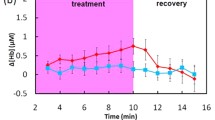Abstract
Low-intensity (therapeutic) laser therapy (LILT) has become a popular therapeutic modality for use by physiotherapists in the clinical management of a wide variety of conditions, including the promotion of wound repair and as an hypo-algesic agent. Nevertheless, the scientific data in support of the continued application of lasers in the clinic remains sparse, although recent studies have demonstrated a number of quantifiable biological effects of low-intensity laser, including laser-mediated increases in human median nerve conduction latency in vivo. In the present study, the effect of irradiation with low-intensity laser (1.5 J cm−2; 830 nm) on forearm skin blood flow in humans has been assessed using a laser Doppler flowmeter: (1) under resting conditions; (2) with concomitant measurement of antidromic median nerve conduction latency; and (3) after raising skin blood flow by immersion of the arm in water at 45 ‡C for a period of 10 min. Under resting conditions and with concomitant measurement of nerve conduction latencies, irradiation at the parameters stated produced no dramatic change in the measured red cell flux signal (RCFS). However, when the latter was raised by pre-heating the limb, laser irradiation effected a significant reduction in measured flux when compared to placebo at 20 min post-irradiation. Such an effect of LILT indicates a laser-induced reduction in skin blood flow. These findings may have importance to our further understanding of laser's effects in vivo and its putative clinical efficacy.
Similar content being viewed by others
References
Baxter GD.Therapeutic Lasers: Theory and Practice. Edinburgh: Churchill Livingstone, 1994:259
Basford JR. Low energy laser therapy: controversies and new research findings.Lasers Surg Med 1989,9:1–5
Devor M. What's in a beam for pain therapy?Pain 1990,43:139
Glassberg E, Lask GP, Tan EML, Uitto J. Cellular effects of the pulsed tunable dye-laser at 577 nanometers on human-endothelial cells, fibroblasts, and erythrocytes-anin vitro study.Lasers Surg Med 1988,8:567–72
Gross AJ, Jelkmann W. Helium-neon laser irradiation inhibits the growth of kidney epithelial cells in culture.Lasers Surg Med 1990,10:40–4
Karu TI. Effects of visible radiation on cultured cells.J Photochem Photobiol 1990,52:1089–96
Funk JO, Kruse A, Kirchner HJ. Cytokine production after helium-neon laser irradiation in cultures of human peripheral blood mononuclear cells.J Photochem Photobiol 1992,16:347–55
O'Kane S, Shields TD, Gilmore WS, Allen JM. Low intensity laser irradiation inhibits tritiated thymidine incorporation in the hemopoietic cell lines HL-60 and U937.Lasers Surg Med 1994,14:34–9
Baxter GD, Walsh DM, Allen JM, Lowe AS, Bell AJ. Effects of low intensity infrared laser irradiation upon conduction in the human median nervein vivo.Exp Physiol 1994,79:227–34
Lowe AS, Walsh DM, Baxter GD, Allen JM. Effects of low intensity laser (830 nm) upon forearm skin blood flow in humans.J Physiol 1994,480:137
Snyder-Mackler L, Bork CE. Effect of Helium-Neon laser irradiation on peripheral sensory nerve latency.Phy Ther 1988,68: 223–5
Bircher A, De Boer EM, Agner T, Wahlberg JE, Serup J. Guidelines for measurement of cutaneous blood flow by Laser Doppler Flowmetry.Cont Dermat 1993,28:1–8
Watkins D, Holloway GA. An instrument to measure cutaneous blood flow using the doppler shift of laser light.IEEE Trans Biomed Eng 1978,25:28–33
Johnson JM, Taylor WF, Sheperd AP, Park MK. Laser-Doppler measurement of skin blood flow: comparison with plethysmography.J App Physiol 1984,56:798–803
Waeber B, Schaller M, Nussberger J, Bussien J, Hofbauer KG, Brunner HR. Skin blood flow reduction induced by cigarette smoking: role of vasopressin.Am J Physiol 1984,247:H895–901
Fagrell B. Dynamics of skin microcirculation in humans.J Cardio Pharmacol 1985,7:S53–8
Muller P, Keller R, Imhof P. Laser Doppler Flowmetry, a reliable technique for measuring pharmacologically induced changes in cutaneous blood flow?Meth Find Exp Clin Pharmacol 1987,9: 409–20
Barnes MD, Peppiatt TN, Mani R. Glimpses into measurements of the microcirculation in skin.J Biomed Eng 1991,13:185–8
Lynn B, Cotsell B. The delay in onset of vasodilator flare in human skin at increasing distances from a localized noxious stimulus.Microvasc Res 1991,41: 197–202
Bickerstaff M, Ward J. Comparison of skin blood flow in man measured by near infra-red laser Doppler flow-meter and by plethysmography.J Physiol 1992,446:579P
Vongsavan N, Matthews B. Some aspects of the use of laser doppler flow meters for recording tissue blood flow.Exp Physiol 1993,78:1–14
Lowe AS, Baxter GD, Walsh DM, Allen JM. The effect of low intensity laser irradiation (830 nm) upon skin temperature and antidromic conduction latencies in the human median nerve: relevance of the radiant exposure.Lasers Surg Med 1994,14:40–6
Furchgott RF. The pharmacology of vascular smooth muscle.Pharmacol Rev 1955,7:183–265
Furchgott RF, Ehrreich SJ, Greenblatt E. The photo-activated relaxation of smooth muscle of rabbit aorta.J Gen Physiol 1961,44:499–519
Furchgott RF, Martin W, Jothianandan D, Villani GM. In: Paton W, Mitchell J, Turner P (eds)Proceedings of the IUPHAR 9th International Congress of Pharmacology. London: Macmillan, 1984:149–57
Furchgott RF, Jothianandan D. Endothelium-dependent and independent vasodilation involving cyclic GMP: relaxation induced by Nitric Oxide, Carbon Monoxide and light.Blood Vessels 1991,28:52–61
Matsunaga K, Furchgott RF. Interactions of light and sodium-nitrite in producing relaxation of rabbit aorta.J Pharmacol Exp Therapeut 1989,248:687–95
Clyman RI, Rudolph AM. Patent ductus arteriosus: a new light on an old problem.Ped Res 1978,12:92–4
Barefield ES, Dwyer MD, Reese JF, Cassady G. Association of patent ductus-arteriosus (PDA) and phototherapy (PT) in infants less-than-or-equal-to 2000G.Paed Res 1990,7:197A
Rosenfeld W, Sadhev S, Brunot V, Jhaveri R, Zabaleta I, Evans HE. Phototherapy effect on the incidence of patent ductus arteriosus in premature infants: prevention with chest shielding.Pediatrics 1986,78:10–4
Author information
Authors and Affiliations
Rights and permissions
About this article
Cite this article
Lowe, A.S., Walsh, D.M., Baxter, G.D. et al. Low-intensity laser irradiation (830 nm) reduces skin blood flow in humans. Laser Med Sci 10, 245–251 (1995). https://doi.org/10.1007/BF02133616
Received:
Issue Date:
DOI: https://doi.org/10.1007/BF02133616




